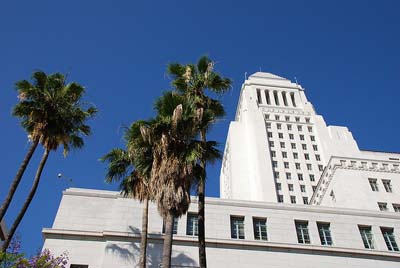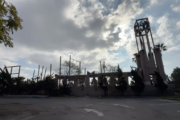Brie Loskota testified at a public hearing hosted by Mayor Antonio Villaraigosa and the Los Angeles City Human Relations Commission. The event, “L.A. Civil Unrest: A Community Blueprint for the Next 20 Years,” took place on April 24, 2012 at City Hall and included remarks by Cecil “Chip” Murray, LAPD Chief Charlie Beck, and L.A City Controller Wendy Greuel.
THE CENTER FOR RELIGION AND CIVIC CULTURE was founded in the wake of the 1992 civil unrest, seeking to understand what faith communities were doing to rebuild L.A. What we found was enormous drive and energy poured into building connections and coalitions after 1992. By about 1995, much of that initial energy had faded. The collaborations that were able to develop an institutional base and operational home were maintained, but many other efforts that lacked formal structure faded. Faith communities have always engaged in social services, healing and building better neighborhoods. For many, it is the bedrock of their identities and their DNA.
Since 1996, and the passage of welfare reform legislation, there has been greater emphasis on faith based outreach and engagement by government agencies at nearly every level. Public agencies and officials are hoping to tap into this long-standing orientation, and also the resources (spatial, material, human, fiscal) to help deal with some of our nation’s most difficult problems.
At the same time, the social safety net, as President Reagan called it, has been unraveling. Congregations are under greater pressure to fill in the gaps and meet the needs of communities that were left as government programs changed, ended, or had less money.
We now expect congregations to have a greater social role, yet they face the issue of scarce resources as do public agencies. The congregations themselves are often a microcosm of the great needs that are felt in communities. Clergy, many in urban congregations, do not have any financial support from their congregations, and the congregations themselves struggle to fill the role that the state has abdicated to them.
While there are exemplary congregations with thousands of members, the median size of a congregation in America is only 75 members. Thus, when we think about faith communities, we need to expand what is in our mind, moving beyond our ideas of large congregations as the normative model for the faith community, and include the small Latino storefronts of Koreatown, the mid-sized historically black congregations in the Latino neighborhoods of South Los Angeles, mosques and synagogues in West L.A. that serve different parts the Persian community, multiracial evangelical churches in Hollywood, and the dozens of religious minorities that exist in our city, some of which are never discussed.
Since about 1992 there has been tremendous growth in religious life in L.A. county. Congregations, which numbered 3,500 in 1990, are nearly 8,900 today. In 1995, there were approximately 4,000 religious nonprofits. In March of 2012, there were around 8,385, and now there are fewer due to the economic climate and scarce resources for both congregations and nonprofits.
This broader view of faith communities complicates faith-based outreach.
Working with faith communities is a difficult task that is made even more difficult by the fact that there is little or no training given to local faith liaisons working in state, county and city departments. Thus, the liaisons do not have an adequate understanding about which faith communities are active in a particular geography, how to go about engaging with them, what the goals of engagement are—beyond engaging for engagement’s sake—and who else within other government agencies might be working to do outreach to the same groups. The one exception where this issue does exist is related to national security and terrorism. There are multi-department roundtables that share information and discuss outreach related to national security concerns but the same information sharing ability and drive does not exist when it comes to things like social services outreach. Training support, goal development and information sharing needs to happen across agencies that work on faith engagement, beyond just asking the faith community to show up at events and checking a box that faith outreach has been completed.
A disaster is a horrible place to exchange business cards and an even worse place to try to find out about the sensitivities and nuances of working with your newly identified partners.
These opportunities are especially important, as Rev. Cecil “Chip” Murray notes: 1992 was a wake-up call to faith communities to see what was in place, what worked and what didn’t. In the four years following the fires and unrest, a lot of attention was paid to bridging divides of race, class and religion to come together to rebuild the city. In 1992, if you had a Protestant, Catholic and Jew working together that was pretty remarkable, especially if they bridged ethnic and class divides.
This work needs to continue, needs to deepen, and needs to expand. Again, after the tragedy of 9/11, our attention was once again refocused on the need for our communities to come together and show how we are from many different places and many different backgrounds but we are all part of Los Angeles and this nation. Now we have greater participation of Mormons and Muslims, further broadening our understanding of the faith community. This, in my view is a good thing and it is something that the younger generations seem to be more closely in touch with as they continue to see the strength in a diversity of views, practices, colors and faiths.
Faith communities that want to engage in social programs that will benefit all in the community are often hamstrung by restrictive code and ordinances. For example, one congregation we interviewed wanted to start a food program and had a kitchen that needed renovation. Renovating the kitchen would have cost them about $200,000 but with all the code issues, permits, etc. the congregation estimated that total cost was closer to $1 million and they had to abandon the project due to financial constraints. There must be a way to balance the important safety concerns with the need to allow groups to develop much needed social programs that meet unmet needs. Congregations and other faith-based organizations should be encouraged to develop “standing capacity” that can be tapped in case of an emergency or disaster but the current system discourages these programs and reduces capacity.
Overall, faith-based organizations are a key element in reweaving our social safety net in an age of doing more with less. But they cannot do it alone and they need partners at all levels of government in order to convert their latent capacity and interest into operational capacity and the know-how to get the job done.
Photo Credit: Floyd B. Bariscale
Brie Loskota is the former executive director (2016-2021) of the USC Center for Religion and Civil Culture.





